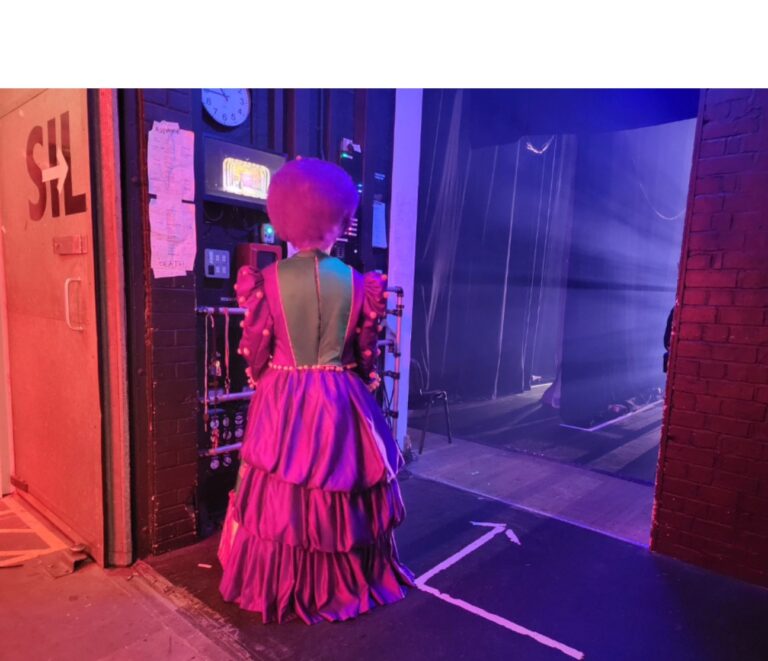Fast fashion is constantly on the news for damaging our environment. From its impact during manufacturing to the damage caused by its disposal by each increasingly short-lived garment, fast fashion hasn’t got the best reputation. And yet the fast fashion industry continues to grow, fuelled by our very purchases. As costume professionals, we often turn to fast fashion brands for convenience or budget restraints, but would your approach be different if you knew how much damage these purchases might be doing after our productions have finished?
A Very Brief History of Fast Fashion
In the past century, our attitude towards clothing has shifted from being valued items that we would care for, repair and re-wear, to consumables that we’ll toss away the minute we are bored of them. “Fast Fashion” really took off in the 1960s when clothes rationing (as a result of WW2) was finally fully lifted and when people found themselves with more disposable income than ever before.
Brands like “Biba” began catering to this new financial freedom, recognising that if they kept prices low, customers were more likely to come back and buy again. This remains the framework that high-street brands, such as H&M and Primark, work to today. In addition to keeping fashion affordable, today’s high-street brands have also upped the number of collections they launch in a year; from the traditional two seasons to a weekly turnaround of new items which makes the buyer feel like they need to keep coming back to keep up with the latest trends. However, fast fashion powerhouse Shein adds new collections daily with a reported 10,000 new items to its website every day! The high turnaround of clothes in the shops is reflected in the high turnaround of clothes in the average wardrobe today. Clothing has become a “consumable.” It’s not generally bought to last anymore. So what impact is getting rid of these clothes having?
Landfills
30% of our unwanted clothing in the UK goes straight to landfill where it will take centuries to fully break down. Most modern clothes will have some element of plastic: plastic buttons and zips, polyester fabrics etc. When plastic breaks down it doesn’t become part of the earth again in the same way that organic fabric like cotton will. Plastics just break down into ever smaller plastic particles called microplastics. Microplastic can make its way into water systems when rain washes and drains it off landfill sites and into our natural water sources.
Environmental scientists are only truly beginning to understand the real implications that microplastics are having on the environment and our health, but research so far has unanimously pointed to it not being good!
Charity Shops in Crisis
To avoid sending our clothes to landfill, many opt to send unwanted clothes to charity shops. However, our charity shops are being inundated with fast fashion clothing, bearing the brunt of much of our throw-away culture. We feel good about donating because we think it’s doing good while liberating wardrobe space for new clothes in our wardrobes, however, charity shops are struggling to cope with our mammoth clear-outs. More clothes are being donated to charity than are bought. On top of this, a lot of the clothing donated isn’t good enough quality to sell thanks to it being poorly produced by companies catering for the one-time-wear attitude. These clothes might be sent to a recycling plant but also may be sent straight to landfill.
Sending Clothing Overseas
Some charities send unsold donations abroad to be resold in developing countries. When these exporting initiatives began it seemed like a good “solution” for all. But now, developing countries have also become inundated with more Western fashion than they need or have the right infrastructures to dispose of safely. Most of the clothing will likely be burnt on landfill heaps, releasing toxic fumes from the synthetic fibres into the immediate environment. These landfills are often near water sources and close to communities, not isolated like our landfills in the UK often are. The toxins find their way into drinking water, people’s homes, schools, and workplaces, creating an environment that is hazardous to people’s health. More recently, photos of Ghanaian beaches piled with mountains of Western clothes have been circulating on social media. These clothes have been dumped near waterways, washed out to sea and back onto Ghana’s beaches. The result is more than just the destruction of natural beauty; it is also having a profound impact on the country’s fishing industry, reducing the number of fish fishermen can catch and sell. Charities try in vain to clear the waste, only for it to be replaced again by the next tide.
Textile Recycling
Textile recycling sounds like it could be the real solution for any clothes that aren’t fit for the charity shop, and it is for clothing made of natural fibres that can be easily shredded and remade into new materials. However, many clothes today are made of complex man-made fibres making the different types of fibres hard to separate out, often making the process more costly and more damaging to the environment than if the clothes are sent to landfill.
Summary
It’s hard to know exactly what to do with old clothes when you are aware of the negative environmental impact it has the potential to have. If you can, buy less and better-quality clothing that will last you longer with the proper care. And when the time does eventually come to say goodbye to an item of clothing, carefully weigh up your options. Is it suitable to be resold at a charity shop? Could you keep it for crafting or garage rags? Is it best sent to textile recycling? We’ll never have full control over what happens when we part with an item of clothing, but we can do our best to make an informed decision based on what we know.
Recommended reading/watching:
“How to Break Up With Fast Fashion” by Lauren Bravo
“Buy Now: The Shopping Conspiracy” on Netflix
Meg McGowan’s Jeans Experiment- https://permacultureaustralia.org.au/the-great-
stretch-jean-challenge/
This article was written by Katie Unwin and their bio will be updated shortly
TWC Thoughts: Knowing this, what can we as an industry, who works with clothing on a daily basis, do differently? Are there easy steps we can take to be more sustainable? Do people have any top tips??







